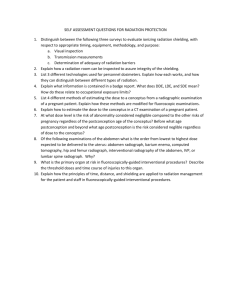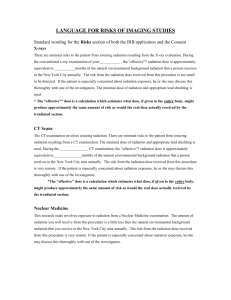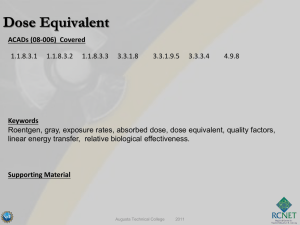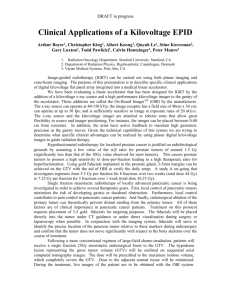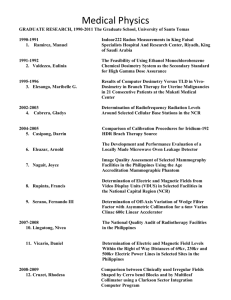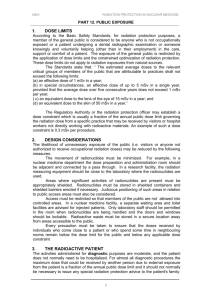Standard ICF Statements
advertisement
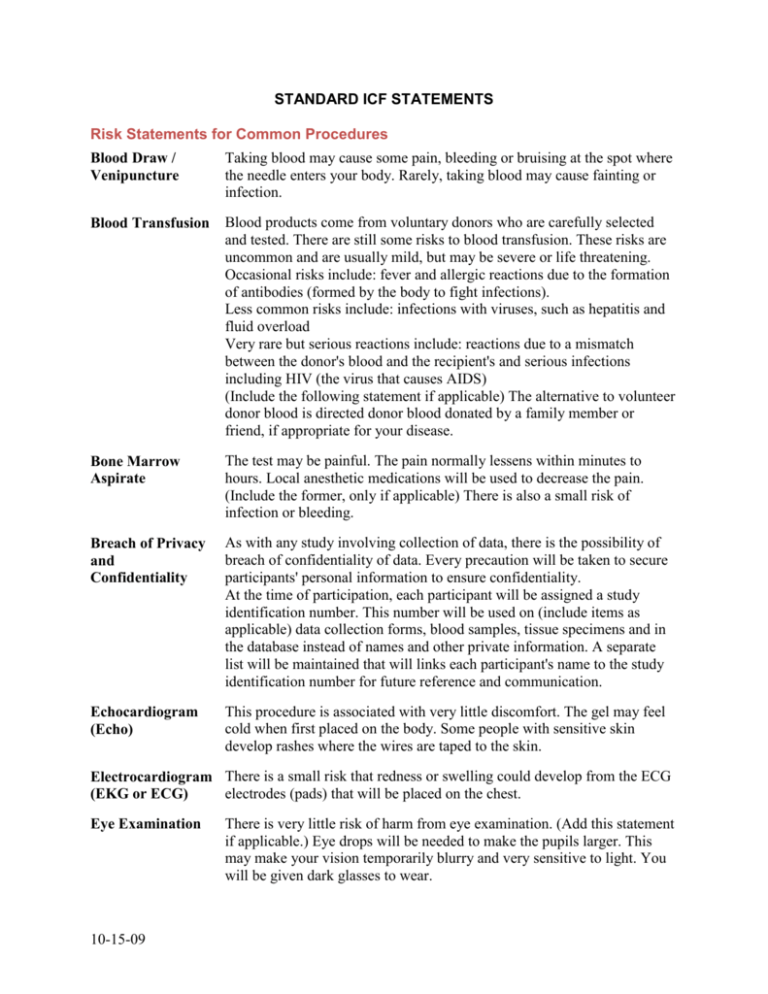
STANDARD ICF STATEMENTS Risk Statements for Common Procedures Blood Draw / Venipuncture Taking blood may cause some pain, bleeding or bruising at the spot where the needle enters your body. Rarely, taking blood may cause fainting or infection. Blood Transfusion Blood products come from voluntary donors who are carefully selected and tested. There are still some risks to blood transfusion. These risks are uncommon and are usually mild, but may be severe or life threatening. Occasional risks include: fever and allergic reactions due to the formation of antibodies (formed by the body to fight infections). Less common risks include: infections with viruses, such as hepatitis and fluid overload Very rare but serious reactions include: reactions due to a mismatch between the donor's blood and the recipient's and serious infections including HIV (the virus that causes AIDS) (Include the following statement if applicable) The alternative to volunteer donor blood is directed donor blood donated by a family member or friend, if appropriate for your disease. Bone Marrow Aspirate The test may be painful. The pain normally lessens within minutes to hours. Local anesthetic medications will be used to decrease the pain. (Include the former, only if applicable) There is also a small risk of infection or bleeding. Breach of Privacy and Confidentiality As with any study involving collection of data, there is the possibility of breach of confidentiality of data. Every precaution will be taken to secure participants' personal information to ensure confidentiality. At the time of participation, each participant will be assigned a study identification number. This number will be used on (include items as applicable) data collection forms, blood samples, tissue specimens and in the database instead of names and other private information. A separate list will be maintained that will links each participant's name to the study identification number for future reference and communication. Echocardiogram (Echo) This procedure is associated with very little discomfort. The gel may feel cold when first placed on the body. Some people with sensitive skin develop rashes where the wires are taped to the skin. Electrocardiogram There is a small risk that redness or swelling could develop from the ECG electrodes (pads) that will be placed on the chest. (EKG or ECG) Eye Examination 10-15-09 There is very little risk of harm from eye examination. (Add this statement if applicable.) Eye drops will be needed to make the pupils larger. This may make your vision temporarily blurry and very sensitive to light. You will be given dark glasses to wear. Insertion of an Intravenous Catheter (IV) Placing an IV may cause some pain, and bleeding or bruising at the spot where the needle enters your body. Rarely, it may cause fainting. The longer an IV catheter is left in place, the more common it is for redness or infection to develop. Questionnaires and Surveys There are no physical risks but you might experience momentary embarrassment or discomfort. You do not have to answer any questions that make you too uncomfortable. (Add a statement, if applicable, to discuss any counseling that may be available as a result of concerns that are raised.) Reproductive Risks For female subjects: If you are pregnant or nursing, you will not be allowed to participate in this study. You will need to take safety measures to prevent pregnancy (such as not having sexual intercourse, or using a medically accepted form of contraception) for a minimum of ____(time period before, during and after the study). If you have questions about how to avoid pregnancy, talk to your doctor or the researcher and they will provide you with information on contraceptive choices. You should contact Dr. XXXXX at once if you become pregnant during this research study. For male subjects: You should not father a baby for a minimum of _____ after administration of ___________. You need to take safety measures to prevent pregnancy (such as not having sexual intercourse or using contraception) for a minimum of ____ after administration of ____. If you have questions about how to prevent pregnancy, talk to your doctor or the researcher and they will provide you with information on contraceptive choices. Upper GI Endoscopy 10-15-09 Possible risks and discomforts associated with the endoscopy procedure include gagging, nausea, vomiting, sore throat and possible reaction to the numbing medicine used during the procedure. There are other less common risks of endoscopy. (if GI endoscopy will be done by someone who isn't an investigator, add this statement) The doctor performing the endoscopy will explain these risks to you in more detail before you have the endoscopy procedure. Risk Statements for Radiology Procedures Ionizing Radiation Name of Procedure General Statement for Ionizing Radiation For procedures and exposures less than 5,000 mrem effective dose for children and 10,000 mrem for adults This study involves exposure to radiation from a name of procedure. You will therefore receive a radiation dose. This dose is not necessary for your medical care. You will get the radiation only because you are taking part in this study. Radiation can increase the risk of cancer after many years but at a dose much higher than you will get. Because of the low dose of radiation, it is very likely that you will see no ill effects. Contrast Agent Add this statement when a contrast agent will be used You will receive a contrast agent as part of your name of procedure. Contrast agents can cause allergic reactions and kidney damage. Allergic reactions can include mild itching associated with hives and can be as serious lifethreatening emergency from difficulties breathing. If this occurs, it is treatable. DXA and pQCT This research study involves exposure to a small dose of radiation from a name of procedure. This radiation dose is not necessary for your medical Scans care and will occur only as a result of your participation in the study. At doses much higher than you will receive, radiation is known to increase the risk of developing cancer after many years. At the doses you will receive, it is unlikely that you will see any effects at all. Non-Ionizing Radiation Magnetic Resonance Imaging (MRI) 10-15-09 There are no known risks of physical harm associated with MRI. However, MRI machines produce loud banging noises, which cause some people to become stressed or upset. You may also feel uncomfortable inside the magnet if you do not like to be inside small places or have difficulty lying still. The MRI magnet is always on and attracts certain metal objects. Any metal objects on or inside of your body may heat up, move, and/or not function properly within the scanning room. Metal objects in the room can fly through the air toward the magnet and hit those nearby. There are many safety measures in place to reduce these risks. The staff will screen all persons and materials entering the scanning room for metal. When the study begins, the door to the room will be closed to minimize the risk of someone accidentally bringing a metal object into the scanner room. Risk Statements for General Anesthesia and Sedation General Anesthesia You may need GA in order to have a name of procedure. There are very rare but serious side effects associated with general anesthesia including: irregular heartbeat, increases or decreases in blood pressure, rare reactions to medications used in the anesthesia, and blockage of breathing passages. An extremely rare but serious complication is rapid increase in body temperature. All of these complications are treatable but might lead to coma or even death. You will have an opportunity to discuss these risks with the anesthesiologist. Sedation You may need sedation to make you sleepy for name of procedure. Sedative medicines may make you sleep for several hours and sometimes can have prolonged effect. Uncommon but serious complications include: irregular heartbeat, increases or decreases in blood pressure, rare reactions to medications used, and blockage of breathing passages. All of these complications are treatable but rarely, may lead to coma or even death. Emergency personnel and equipment will be available in the event of a serious adverse reaction to sedation. You will have an opportunity to discuss these risks and the specific drugs that will be used with the nurse or doctor who will supervise the sedation. Transport under General Anesthesia During transport to and from location #1 to location #2 there is a small risk that the breathing tube or an intravenous catheter may come out. If either problem happens, it could result in serious breathing or bleeding problems. To minimize the likelihood of any harm, your child's anesthetic care will be directed by experienced anesthesiologists with assistance from nurses and respiratory therapists during the scheduled procedure and transport. You will have an opportunity to discuss these risks with the anesthesiologist. 10-15-09
